Product Review - Alternate Audio BCAP
Preamplifier and CA-35 Power Amplifier - April, 1998
John E. Johnson, Jr.
![]()
 |
BCAP Solid
State Preamplifier Class A, Single Ended, Stereo Mfr. FR: DC - 40 kHz + 0 Db - 1 dB Input Impedance: 15 kOhm Size: 2"H x 15 1/2"D x 10 1/2"D Weight: 8 Pounds MSRP: $1,500 |
 |
CA-35 Solid State Power Amplifier Class A, Single Ended, Stereo 25 Watts/Channel into 8 Ohms Mfr. FR: DC - 40 kHz + 0 dB - 1 dB Input Impedance: 15 kOhm Size: 4"H x 17 1/2"W x 15"D Weight: 24 Pounds MSRP: $2,500 |
| Alternate Audio L.C., 1768 North 980 West, Orem, Utah 84057; Phone 801-434-7226; Fax 801-434-7226; E-Mail [email protected]; Web: http://www.alternate-audio.com |
Class A, single ended tube preamplifiers and power amplifiers have enjoyed a renaissance over the past few years, but Class A, single ended solid state power amplifiers are not very common. Only a handful of manufacturers produce them. Alternate Audio is one of those manufacturers. They have been in business since 1986, which isn't very long, but then, there are lots and lots of young companies in the hi-fi business now.
Dan Patten designs the components marketed by Alternate Audio, which he owns. When you own the company, design the products, and market them yourself, you can save a bunch of money and put it into the product. I think that is what happened with the two products I report on here.
The BCAP Preamplifier and CA-35 Power Amplifier are similar in that
each has only two gain stages (most amplifiers have at least three). The first is the
voltage gain stage (the input stage), which is differential (one MOSFET for the + leg and
one for the - leg of the signal). The second stage is for current gain (the output stage),
and is single ended. 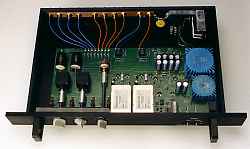 The BCAP
has one MOSFET for this purpose, while the CA-35 has three, in parallel. In order for the
input stage to be coupled to the output stage without a driver stage in between, the input
stage has to be high biased so that enough current is available to drive the output stage
by itself. This makes the components run quite warm, at least for the CA-35.
The BCAP
has one MOSFET for this purpose, while the CA-35 has three, in parallel. In order for the
input stage to be coupled to the output stage without a driver stage in between, the input
stage has to be high biased so that enough current is available to drive the output stage
by itself. This makes the components run quite warm, at least for the CA-35. 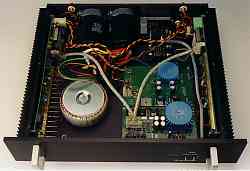 The power supplies for the two
stages in each component are separate. In the case of the BCAP, there are � 22 Volts on
8,000 �F of capacitors for the input stage, producing 2 Joules of energy storage. For the
output stage, there are � 15 Volts on 8,000 �F of capacitors, producing 1 Joule of
energy. The CA-35 has a larger power supply, with the same 2 Joules of energy for the
input stage, but � 15 Volts on 660,000 �F of capacitors, for 148.5 Joules, handling the
output stage. This is a LOT of energy storage for 25 watts per channel, but that is what
it takes for Class A, and it allows for more headroom when short term transients require
it. With a high performance Class A/B power amplifier, it might have half or one third as
many Joules of energy storage in the power supply as the rated output (8 Ohms) in watts
(all channels added together). For Class A power amplifiers, you will have something
around three times as many Joules of energy storage as rated output in watts. This is a
major reason why Class A amplifiers are so expensive.
The power supplies for the two
stages in each component are separate. In the case of the BCAP, there are � 22 Volts on
8,000 �F of capacitors for the input stage, producing 2 Joules of energy storage. For the
output stage, there are � 15 Volts on 8,000 �F of capacitors, producing 1 Joule of
energy. The CA-35 has a larger power supply, with the same 2 Joules of energy for the
input stage, but � 15 Volts on 660,000 �F of capacitors, for 148.5 Joules, handling the
output stage. This is a LOT of energy storage for 25 watts per channel, but that is what
it takes for Class A, and it allows for more headroom when short term transients require
it. With a high performance Class A/B power amplifier, it might have half or one third as
many Joules of energy storage in the power supply as the rated output (8 Ohms) in watts
(all channels added together). For Class A power amplifiers, you will have something
around three times as many Joules of energy storage as rated output in watts. This is a
major reason why Class A amplifiers are so expensive.
The looks of the two components are simple and elegant. On the front
are Volume, Balance, and Source Selector controls, as well as On/Off and Standby/Mute toggles. LEDs indicate when the internal solenoids have switched to
"ready" and also illuminate the edges of the controls (in red).  Overload or
too much DC offset from inputs will switch the component back into standby mode. The controls all work smoothly, but I found the Balance control overly sensitive, as the right or left is attenuated too quickly.
Overload or
too much DC offset from inputs will switch the component back into standby mode. The controls all work smoothly, but I found the Balance control overly sensitive, as the right or left is attenuated too quickly.
The rear panel has gold plated RCA input jacks for four inputs,
labeled 1,2,3, and 4 on the BCAP, and one set of inputs on the CA-35.  The BCAP has one set of RCA output jacks, and
the CA-35 has one set of very heavy five-way speaker binding posts. There are also on/off
rocker switches on the back of each component which allow trickle current to keep the
circuits warm. One thing I found to be a little odd was the fact that the left/right input
and output labels were on opposite sides for the two components. This would mean that if
you had the BCAP on the shelf above the CA-35, you would have to cross the interconnects
right to left, and left to right, assuming you used the labels as is.
The BCAP has one set of RCA output jacks, and
the CA-35 has one set of very heavy five-way speaker binding posts. There are also on/off
rocker switches on the back of each component which allow trickle current to keep the
circuits warm. One thing I found to be a little odd was the fact that the left/right input
and output labels were on opposite sides for the two components. This would mean that if
you had the BCAP on the shelf above the CA-35, you would have to cross the interconnects
right to left, and left to right, assuming you used the labels as is.
The BCAP tests showed it to have + 3.5 mV of DC offset, and was 3 dB
down at 95 kHz from the measurement at 10 kHz. 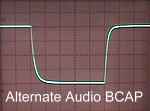 The
The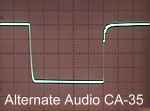 CA-35 had a DC offset of +
0.75 mV and was 3 dB down at 267 kHz. Square wave response (� 10 Volts, 10 kHz) was much
different between the two, reflecting not only the bandwidth, but some ringing that was
present in the CA-35 (see closeup photo of CA-35 response below at right). Notice that on the
upswing portion of the waveform, it is almost perfectly straight for most of the upswing
(where the electron beam path on the oscilloscope is faint). This means the amplifier is
very fast. Ringing can be present when the amplifier has a large bandwidth, such as the
CA-35. It can be reduced by lowering the bandwidth, but a smaller bandwidth can alter the
phase response in the audio band. Ringing can also be reduced by adding negative feedback.
There is no negative feedback in either the BCAP or the CA-35, except for DC back to the
input. With single ended designs, it really isn't necessary if the circuit is linear to
begin with. Negative feedback reduces 2nd order distortion, but increases 5th, something
you would definitely not want with an amp like this. That would be like taking part of the
sugar out of a recipe and replacing it with a tablespoon of vinegar. C'est la vie.
CA-35 had a DC offset of +
0.75 mV and was 3 dB down at 267 kHz. Square wave response (� 10 Volts, 10 kHz) was much
different between the two, reflecting not only the bandwidth, but some ringing that was
present in the CA-35 (see closeup photo of CA-35 response below at right). Notice that on the
upswing portion of the waveform, it is almost perfectly straight for most of the upswing
(where the electron beam path on the oscilloscope is faint). This means the amplifier is
very fast. Ringing can be present when the amplifier has a large bandwidth, such as the
CA-35. It can be reduced by lowering the bandwidth, but a smaller bandwidth can alter the
phase response in the audio band. Ringing can also be reduced by adding negative feedback.
There is no negative feedback in either the BCAP or the CA-35, except for DC back to the
input. With single ended designs, it really isn't necessary if the circuit is linear to
begin with. Negative feedback reduces 2nd order distortion, but increases 5th, something
you would definitely not want with an amp like this. That would be like taking part of the
sugar out of a recipe and replacing it with a tablespoon of vinegar. C'est la vie.
I 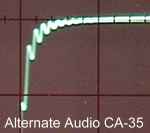 listened to the BCAP and CA-35 with
an Audio Alchemy CD package, Monitor Audio Studio 20 SE Speakers, and Nordost SPM
Reference Interconnects and Speaker Cables. For a 25 watt/channel amplifier, the CA-35 had
plenty of dynamics. That is the speed and overhead in the power supply of a Class A
amplifier. The preamp and power amp together also sounded very sweet and mellow, with no
harshness even when cranked. That's single ended performance, which eliminates odd ordered
harmonics (odd ordered harmonics, e.g., 3rd and 5th, sound irritating, while even ordered
harmonics, e.g., 2nd and 4th, can actually be pleasant).
listened to the BCAP and CA-35 with
an Audio Alchemy CD package, Monitor Audio Studio 20 SE Speakers, and Nordost SPM
Reference Interconnects and Speaker Cables. For a 25 watt/channel amplifier, the CA-35 had
plenty of dynamics. That is the speed and overhead in the power supply of a Class A
amplifier. The preamp and power amp together also sounded very sweet and mellow, with no
harshness even when cranked. That's single ended performance, which eliminates odd ordered
harmonics (odd ordered harmonics, e.g., 3rd and 5th, sound irritating, while even ordered
harmonics, e.g., 2nd and 4th, can actually be pleasant).
Although this package performed nicely with symphonic music (Rachmaninov Piano Concerto Number 2) and rock, I really like Class A single ended designs with popular vocal music, such as Tony Bennett, Michael Bolton, and Natalie Cole. There is just something about the design that makes voices mellifluous. When listening to music like this, you don't need a lot of volume, so the dynamics can be spectacular even with just 25 watts. I also listened to the Telarc version of Tchaikovsky's 1812 Overture (Erich Kunzel, Conductor), which has cannons with very intense, very low frequency sounds. I was surprised to find that the CA-35 did not clip, maintaining a modest sound level into a pair of Krix Equinox bookshelf speakers.
In summary, Dan Patten has a pair of winners here, and I look foward to seeing more from this bright young designer in the near future.
John E. Johnson, Jr.
![]()
� Copyright 1998 Secrets of Home Theater & High
Fidelity
Return to Table of Contents for this Issue.

